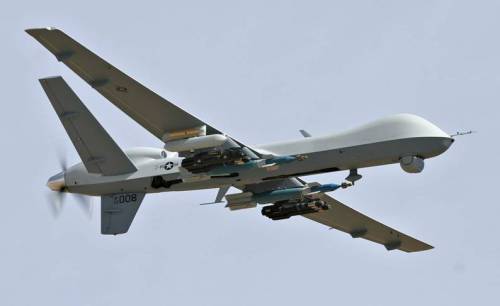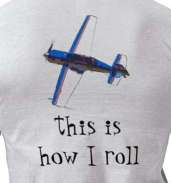The USAF has deployed an unmanned aerial vehicle (UAV) that has more lethality and speed, able to fly 260 knots at FL500. Available options on the MQ-9 “Reaper” include infrared, laser and radar targeting, and your choice of of guided bombs and missiles up to 3,000 pounds. MP3 player not yet available.
A good reason to “Fear the Reaper”. (Apologies to Blue Oyster Cult). It looks plenty tough.

The USAF transition from surveillance to attack is a significant change. Initially, recon was the primary role of the MQ-1 Predator over Iraq. Later they were outfitted with two Hellfire missiles. The Reaper signals a new chapter in Close Air Support as long as air supremacy exists.
The Reaper is four times heavier than the Predator and comparable to the profile of the Air Force A-10. -Less expensive and can do some things manned aircraft cannot. Some see it as the “75% solution”: It accomplishes most of the mission profile in counter insurgency at less expense. A predator is $7.6M; Reaper at $17M (both with ground control stations), compared to tactical aircraft, such as the F-35 , which may top out at over $100M. I have concerns about close air support with a guy dropping weapons having a soda straw view of the battlefield 7,000 miles away. Still, they have great loiter times, are less complex and not subject to G-LOC – loss of consciousness in high performance maneuvers. It takes over a year and $2.5 million to train a fighter pilot. UAV pilots are a fraction of the time and cost: 20 weeks and $135,000.
It stetches the imagination to think of future battles relegated to UAV pilots thousands of miles from each other locked in a video game war: “My drone can beat up on your drone”. It could happen and frankly, I hate to see it.
Which brings me to general aviation. There are UAV’s already in use in law enforcement and border patrol. Some are quite small . Many are pushing for more civilian applications along with a growing list of hobbyists who want to expand the reaches of RC flying so they can have a drone of their own. Exisiting FAA policies currently prevent most UAV’s from flying in national airspace because the agency hasn’t developed procedures for approving them.
The agency is also hesitant to write regulations because it wants to ensure unmanned systems are noticeable to larger manned aircraft. Aerial drones are difficult to see and therefore must have the capability to detect, sense and avoid other aircraft, Duquette says. However, FAA asserts that this technology is “years away.”
How many other applications in the future? Air traffic, firefighting, aerial photography, crop dusting, search and rescue? Is an unmanned commercial carrier in the cards? I know what you’re thinking: Too much time watching movies like iRobot. However, we already have CAT III systems (in the 757 and others) that are able to “self land” and required to do this monthly. It might be the domain of “Popular Science” musings but begs the question: What’s next?


 Despite numerous misadventures, finally got the commercial license and is enjoying aerobatics. My airmanship, like my golf game, says I can't quit my day job.
Despite numerous misadventures, finally got the commercial license and is enjoying aerobatics. My airmanship, like my golf game, says I can't quit my day job. 

And I, for one, DO NOT welcome our new robot pilot overlords.
Once upon a time, people would complain about foreigners taking our jobs. Soon it will be the damn robots.
How true. While machines have been putting people out of jobs for years (euphemistically called productivity improvements) this bothers me in a different sense. It’s about winning wars but how is courage and valor to be defining factors? There’s no “skin in the game” when you’re behind a joystick. I know: Open cockpits and goggles also went the way of the dodo. (That’s Australian isn’t it?).
Good to hear a comment from down under! (Men at Work music coming to mind)…
Oh, I believe they should be part of the mix alright, for all the reasons their adherent’s advance, but NOT as a total replacement–for a couple of reasons. One is the “soda straw” problem Wilco and, quite frankly, everyone involved admits is of concern for CAS battle-field flexibility and 360 degree, 3-dimensional “situational-awareness. ” The other is the fact that warfare is very much a scissors-paper-rock affair and UAVs are notoriously vulurnable to air to air attack by other aircraft as well as the distinct possibility of their control systems being successfully jammed by ECM. The old “don’t put your eggs all in one basket” applies here in spades, IMHO, but I’m afraid once the green eye-shade bean-counters get the bit in their teeth at the prospect of all the $ savings, budgetary considerations, not the reality of tactical needs, will drive the process.
Worse, it will seem eminently “doable” in the absence of serious battle-field opposition as in Iraq & Afghanistan. My fear is that successful utilization experience in relatively benign circumstances where we have total air superiority will lead us to depend over-much on these systems and when we run into an opponent that can seriously challenge for air superiority it will be too late to bring back manned systems in the numbers needed.
Which brings me back to what I regard as the disaster of the Gates inspired limited F-22 buy. EVERYTHING we do depends on air superiority. Once that is lost everything else either goes away or is seriously degraded. We are fooling ourselves if we thing we will never get in a situation where we will not be seriously challenged in this area. We haven’t fought a war without it since the early days of the WWII N. African campaign and at Guadacanal. And if the F-86 hadn’t been introduced in time it would have been touch and go in Korea. Some people need a memory transplant–starting with Gates and the green eye-shade people.
BTW, is Chris Parkes my long-lost 3rd cousin?
PPS: But as I said over at Lex’s place a while ago, if the barco-jets come with cup-holders or better yet, if the AF would institute an “electronic commute”
work-from-home policy I’m out of retirement and there in a heart-beat! 🙂
VX: I worry about the mindset of arming our national defense with a whole bunch of “75% solutions” as well. While drones are quite effective, we seem to be going down the path ruled by the tyranny of the urgent, that is, what can we cut out of the budget. It’s easy to think like this when no one else comes close our current military power. China is aggressively working to challenge us in the future though. Air superiority is a moving target and requires a pipeline of new capabilities and equipment.
Oh…and as relates to Barco Lounger flying from home. You might be on to something: Rent-A-Drone. If you can sell slots for space travel, how about drone rental. With missiles of course. Blow up targets on the range in China Lake from the comfort of home. Of course you’d have an AF guy there to help land the thing. Can’t be any more expensive than a seat on Space Ship One. Maybe Sir Richard already has plans.
I enjoyed reading your post. I was recently talking with some AF fighter pilots about these machines; they weren’t too thrilled their job security is being threatened!
Anna,
Interesting that the AF pilots you mention worry about job security. My initial thought is it may affect future pilot slots but the folks who already have flying jobs would retain them. Drones would logically affect sorties/flying hours that would have been the domain of the fighter pilot so maybe there is a ripple effect somewhere down the line.
My larger concern is the threat of defense budget cutbacks. The decisions we make now will have implications for years to come.